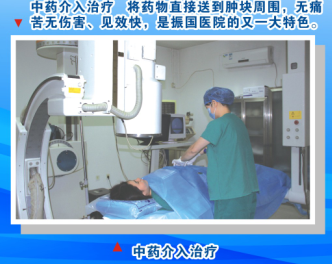
二、介入治疗
2. Intervention therapy
介入放射学又称介入治疗学。是融放射诊断学和临床治疗学于一体的学科。它是在放射诊断设备(数字减影X线机、CT机、核磁共振机和常规X线机等)的指导下,通过微小的创口将特定的器械导入人体病变部位进行治疗的临床应用技术。介入治疗采用“非外科、微创手术”方法可治疗多种疾病。与内科、外科学一道成为临床三大支柱性学科。
The intervention therapy is also called as intervention radiology, and is a discipline combining the radiological diagnostics with clinical therapeutics. In the intervention therapy, under the guidance of radiological diagnostic equipment (e.g. digital subtraction X-ray equipment, CT equipment, MRI equipment and routine X-ray equipment), the specific device is inserted to lesion site for treatment via micro-invasion. It can treat various diseases through the non-surgical and micro-invasive operation. The intervention therapy has become one of three pillar clinical disciplines, the other two of which are internal medicine and surgery.
振国医院临床介入治疗优点在于:
Our intervention therapy possesses the following advantages:
(1)简便、安全、有效、微创和并发症少。
(2)它无需开刀,一般只需要局部麻醉而非全身麻醉,从而降低了危险性。
(3)损伤小、恢复快、效果好,最大限度保护了正常器官。
(4)介入治疗能够尽量把药物局限在病变部位,从而减少对身体和其他器官的副作用。
(1) Operate in a simple, safe, effective and micro-invasive way, with a few complications.
(2) Do not require a surgery or general anesthesia, but just require a local anesthesia, so as to reduce the risk.
(3) Achieve a fast recovery and good efficacy just through a micro-invasion, and protect the normal organs as far as possible.
(4) Restrict the medicines to lesion site as far as possible, so as to reduce the adverse reactions for body and other organs.
正由于以上诸多优点,介入治疗已经成为治疗肝癌、肺癌、腰椎间盘突出症、动脉瘤、血管畸形、子宫肌瘤等疾病最主要的治疗方法之一,甚至取代了原来的外科手术。
With above advantages, the intervention therapy has become one of principal treatment methods and even replaced the surgery for various diseases, e.g. liver cancer, lung cancer, lumbar intervertebral disc protrusion, aneurysm, vascular deformity and hysteromyoma.
|

